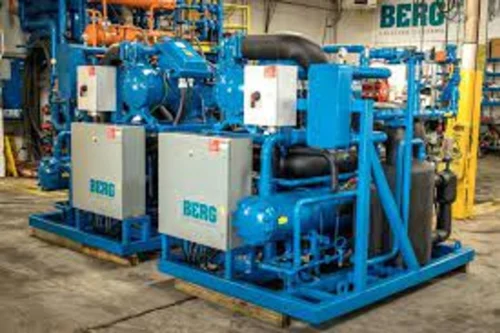
A recovery unit plays a vital role in multiple sectors, from healthcare to the automotive and HVAC industries. Designed to extract and recycle materials or gases, recovery units help ensure both economic and environmental sustainability.
Whether it’s recovering refrigerants, gases, or waste products, these machines can save businesses money, meet regulatory requirements, and promote eco-friendly practices.
In this blog, we’ll dive into what recovery units are, how they function, and their applications across different industries.
What is a Recovery Unit?
A recovery unit is a specialized machine or system used to retrieve, clean, and recycle materials that would otherwise go to waste.
These units are used to recover refrigerants, chemicals, and gases, especially in industries where these elements are critical for operations.
By recovering and recycling valuable substances, businesses can minimize waste, meet regulatory standards, and reduce their environmental impact.
In particular, refrigerant recovery units are essential in HVAC (Heating, Ventilation, and Air Conditioning) systems, helping technicians retrieve and recycle refrigerants from cooling systems without releasing harmful substances into the atmosphere.
Types of Recovery Units
- Refrigerant Recovery Units: Primarily used in HVAC systems to recover and recycle refrigerants such as R-22, R-410A, and other chemicals from air conditioners, refrigerators, and cooling systems.
- Oil Recovery Units: Designed for industries like automotive and manufacturing to extract used oil from machines and vehicles for reuse or safe disposal.
- Gas Recovery Units: Often used in the oil and gas industry to capture gases like methane or carbon dioxide, preventing them from being released into the atmosphere.
- Waste Heat Recovery Units: Common in energy-intensive industries, these units recover heat from industrial processes, allowing it to be reused to power machinery or heat buildings.
How Does a Recovery Unit Work?
Recovery units generally function by extracting materials from equipment, purifying or filtering them, and then storing them for reuse or safe disposal. In the case of refrigerant recovery units, for example, the process typically involves:
- Connection: The unit is connected to the system (e.g., HVAC) from which the refrigerant will be recovered.
- Extraction: The unit then extracts the refrigerant, either in liquid or gas form, from the cooling system.
- Filtration: Any contaminants in the refrigerant are removed during the recovery process.
- Storage: The cleaned refrigerant is then stored in an approved recovery cylinder for future use or safe disposal.
Recovery units typically work within specific regulatory frameworks, such as the EPA regulations for refrigerant handling in the United States, to ensure safety and environmental compliance.
Applications of Recovery Units Across Industries
1. HVAC Industry
The most common application of recovery units is in the HVAC industry, where they are essential for recovering refrigerants.
When servicing or disposing of cooling systems, technicians use recovery units to safely remove refrigerants like Freon, which could otherwise contribute to ozone depletion or global warming.
The use of recovery units ensures that the refrigerants can be reused or properly disposed of, reducing harmful environmental impact.
Furthermore, proper recovery prevents technicians from facing penalties related to non-compliance with environmental regulations like the Clean Air Act.
2. Automotive Industry
In the automotive sector, recovery units are used to reclaim fluids like oil, coolant, and refrigerant from vehicles.
When vehicles undergo servicing or repairs, used oils or coolants can be recovered and either recycled or disposed of safely. This not only reduces waste but also ensures that potentially harmful chemicals don’t pollute the environment.
Additionally, the automotive industry uses recovery units to recycle refrigerants from vehicle air conditioning systems, helping the industry comply with environmental regulations.
3. Oil and Gas Industry
In the oil and gas sector, gas recovery units (GRUs) are used to capture and recycle gases like methane or carbon dioxide that would otherwise be vented or flared.
These units are critical in reducing greenhouse gas emissions, thus helping companies adhere to strict environmental regulations.
By capturing and reusing these gases, the industry not only reduces waste but also enhances energy efficiency.
GRUs also contribute to significant cost savings by reducing the amount of gas lost during production and processing.
4. Industrial and Manufacturing Sectors
Recovery units are also widely used in industrial and manufacturing settings to reclaim materials such as solvents, oils, and gases.
These units can recover waste heat, which can then be reused to power machinery or heat workspaces, improving energy efficiency and reducing operational costs.
In manufacturing, waste heat recovery units (WHRUs) capture and recycle the heat generated during industrial processes, reducing energy consumption and minimizing environmental impact.
Benefits of Using Recovery Units
- Environmental Compliance: Recovery units help businesses meet regulatory requirements for safely handling and recycling hazardous materials. This is particularly crucial in industries like HVAC and oil and gas, where non-compliance can lead to heavy fines.
- Cost Savings: By recovering and reusing valuable materials like refrigerants, oils, or gases, companies can reduce their need for new resources, leading to significant cost savings.
- Reduced Waste: Recovery units play a critical role in reducing waste. Whether it’s recycling refrigerants or capturing gases, these units prevent harmful substances from being released into the environment, promoting sustainability.
- Energy Efficiency: In industries like manufacturing and energy production, recovery units can capture waste heat and reuse it, improving energy efficiency and lowering operating costs.
Conclusion
Recovery units are indispensable in today’s industrial world, where sustainability and efficiency are key goals.
Whether you work in HVAC, automotive, or oil and gas, having a recovery unit ensures your business operates responsibly while meeting regulatory requirements.
More importantly, recovery units promote eco-friendly practices by recycling valuable materials, reducing waste, and minimizing the environmental impact.



